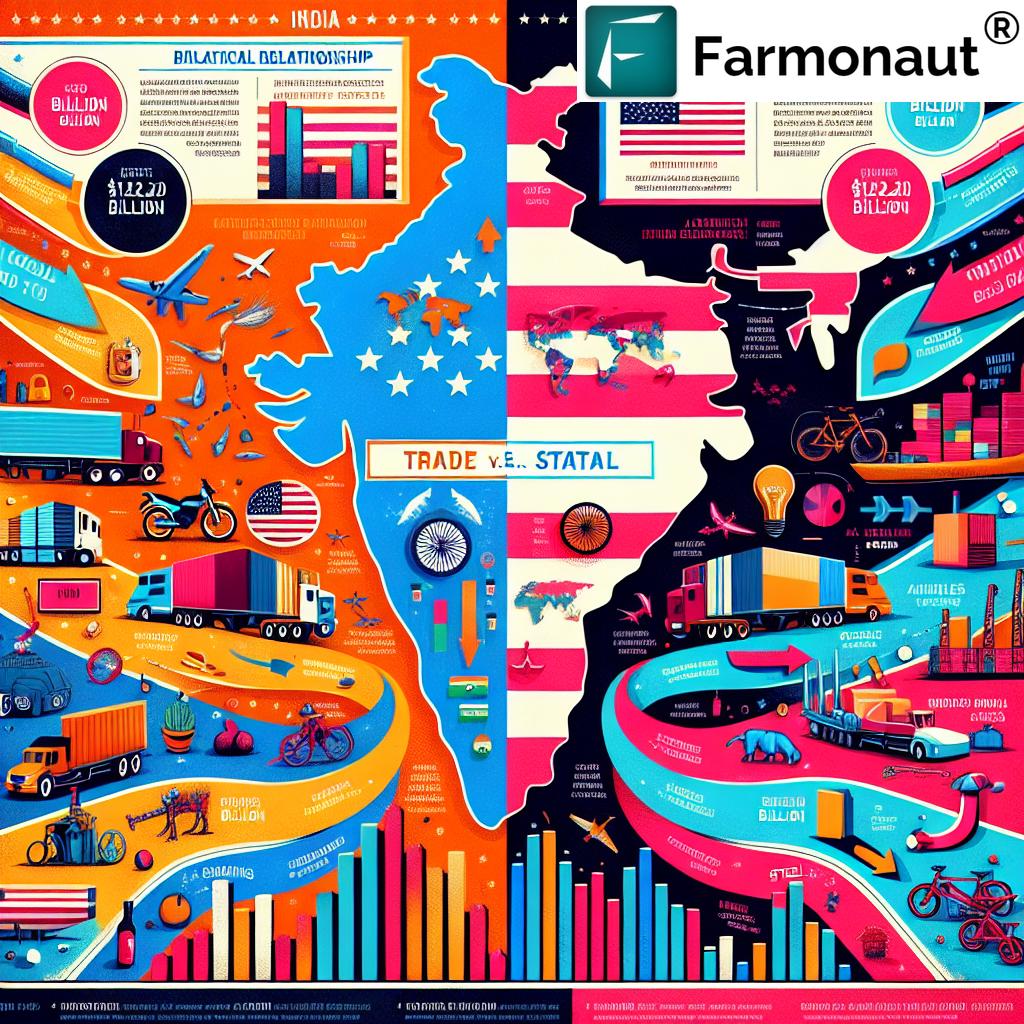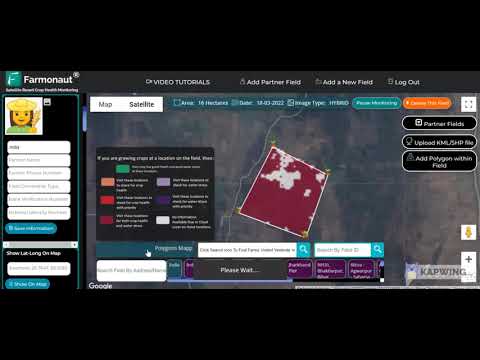US-India Trade Relations: Navigating Tariff Adjustments and Bilateral Agreement Goals for 2030
“US-India trade, currently at $129.20 billion, aims to reach $500 billion by 2030, a 287% increase.”
As we delve into the complex world of international trade, we find ourselves at a critical juncture in US-India trade relations. The landscape is evolving rapidly, with new policies and tariff adjustments reshaping the bilateral dynamics between these two economic powerhouses. In this comprehensive analysis, we’ll explore the current state of affairs, the challenges ahead, and the ambitious goals set for 2030.
The Current State of US-India Trade Relations
The trade relationship between the United States and India has been a cornerstone of economic cooperation between the two nations. As of 2024, this relationship is valued at an impressive $129.20 billion. However, recent developments in US trade policies have introduced new complexities to this dynamic partnership.
President Donald Trump’s administration has been vocal about its intention to implement ‘reciprocal tariffs’ to match the duties that other countries charge on American products. This approach has been particularly focused on addressing what the White House perceives as unfair trade practices, including high tariffs on US agricultural exports to India.

Tariff Adjustments and Their Impact
India has already begun to make tariff adjustments specific to US exports. In the Budget 2025, we saw the relaxation of tariffs on various goods from the US export list:
- Motor bikes: Tariffs reduced from 50% to 40%
- Bourbon whiskey: Tariffs reduced from 150% to 100%
These adjustments signal India’s willingness to work towards more balanced trade relations. However, significant disparities in applied tariffs between the two nations remain a key challenge:
- India’s average tariff: 17%
- US average tariff: 3.3%
The gap is even wider in the agricultural sector, where India’s simple average tariff stands at 39%, compared to just 5% in the US.
New US Tariffs and Their Impact on Indian Exports
The US has recently imposed new tariffs that directly affect Indian exports:
- 25% tariff on almost all steel and aluminium imports
- Potential 25% tariff on auto component imports
- Possible duties on pharmaceutical imports
These tariffs present significant challenges for Indian exporters, particularly in the steel manufacturing sector. However, they also create opportunities in other areas. For instance, the US tariffs on Chinese goods could potentially benefit Indian exporters in sectors such as electronics, textiles, and engineering goods.
“India’s relaxation of duties on US exports, including motorcycles and whiskey, marks a shift towards balanced trade.”
The Road to $500 Billion: Mission 500
Despite these challenges, both India and the US have set ambitious goals for their trade relationship. In February 2025, the two nations issued a joint statement setting a target to double bilateral trade to $500 billion by 2030, a mission aptly named “Mission 500.”
To achieve this goal, both sides have committed to negotiating a Bilateral Trade Agreement (BTA) by fall 2025. The focus areas for this agreement include:
- Fair trade terms
- Improved market access
- Reduction of trade barriers
- Integration of supply chains

Opportunities for Indian Businesses
While the changing trade landscape presents challenges, it also opens up new opportunities for Indian businesses. Here are some key areas where Indian exporters can focus:
- Electronics and Textiles: With US tariffs on Chinese goods, Indian exporters in these sectors may find themselves in a more favorable position.
- Engineering Goods: This sector could see increased demand from the US market.
- Alternative Markets: Indian businesses can explore new markets to mitigate potential losses from US tariff hikes.
- Leveraging Free Trade Agreements: Indian exporters can take advantage of India’s new and upcoming FTAs with countries like the UK, EU members, Oman, and New Zealand to gain access to new markets.
The Role of Technology in Navigating Trade Challenges
As we navigate these complex trade dynamics, technology plays a crucial role in helping businesses adapt and thrive. For instance, in the agricultural sector, which is significantly impacted by trade policies, advanced technologies can help improve productivity and competitiveness.
One such technology solution is offered by Farmonaut, a pioneering agricultural technology company. Farmonaut provides satellite-based farm management solutions that can help farmers optimize their crop yields and reduce resource wastage. This kind of technology can be particularly valuable as Indian agricultural exporters seek to maintain their competitiveness in the face of changing trade dynamics.
For example, Farmonaut’s crop plantation and forest advisory services can help farmers make data-driven decisions about what crops to grow and when, potentially allowing them to pivot towards crops with better export potential. Similarly, the company’s blockchain-based traceability solutions can help ensure that agricultural products meet the stringent quality and safety standards required for international trade.
US-India Trade Relations: Key Metrics and Targets
| Trade Metrics | Current Status (2023) | 2030 Target |
|---|---|---|
| Total Bilateral Trade Value | $129.20 billion | $500 billion |
| US Exports to India | $56.54 billion | To be determined |
| Indian Exports to US | $72.66 billion | To be determined |
| Tariff Rates on Motorcycles | 40% | Under negotiation |
| Tariff Rates on Whiskey | 100% | Under negotiation |
| Number of Sectors with Reciprocal Tariffs | Limited | Increased reciprocity |
Challenges in Achieving Trade Goals
While the goal of doubling bilateral trade to $500 billion by 2030 is ambitious, it’s not without its challenges. Some of the key hurdles include:
- Tariff Disparities: The significant difference in average tariff rates between India and the US needs to be addressed.
- Non-Tariff Barriers: Issues such as regulatory differences and standards alignment need to be resolved.
- Sector-Specific Challenges: Certain sectors, like agriculture and pharmaceuticals, face unique challenges that need targeted solutions.
- Global Economic Uncertainties: Factors such as the ongoing pandemic recovery and geopolitical tensions can impact trade growth.
The Role of Technology and Innovation
As we look towards achieving the ambitious trade goals set for 2030, technology and innovation will play a crucial role. Both countries are leaders in various technological fields, and leveraging these strengths can help overcome trade challenges and create new opportunities.
For instance, in the agricultural sector, which is a significant component of US-India trade, technologies like those offered by Farmonaut can help improve productivity and quality. Farmonaut’s large-scale farm management solutions can be particularly valuable for agribusinesses looking to optimize their operations and meet international standards.
Similarly, Farmonaut’s crop loan and insurance services can help farmers access the financial resources they need to invest in their farms and potentially expand their export capabilities. By providing satellite-based verification for crop loans and insurance, Farmonaut is helping to reduce risk and improve access to financing in the agricultural sector.
The Way Forward: Strategies for Success
To achieve the ambitious trade goals set for 2030, both the US and India will need to implement strategic measures:
- Tariff Harmonization: Gradual alignment of tariff rates to create a more level playing field.
- Sector-Specific Agreements: Focusing on key sectors like agriculture, pharmaceuticals, and technology to address unique challenges.
- Investment in Infrastructure: Improving logistics and supply chain efficiency to facilitate smoother trade.
- Digital Trade Framework: Developing comprehensive policies to govern digital trade and e-commerce.
- Skill Development: Investing in workforce training to meet the evolving needs of export-oriented industries.
Leveraging Technology for Trade Growth
As we navigate the complexities of international trade, technology will play an increasingly important role. Companies like Farmonaut are at the forefront of this technological revolution in agriculture, offering solutions that can help businesses adapt to changing trade dynamics.
For instance, Farmonaut’s fleet management solutions can help agribusinesses optimize their logistics operations, potentially reducing costs and improving efficiency in export operations. Similarly, their carbon footprinting services can help businesses monitor and reduce their environmental impact, which is becoming increasingly important in international trade as more countries implement sustainability requirements.
Conclusion: A New Era of US-India Trade Relations
As we look towards 2030, the US-India trade relationship stands at a crucial crossroads. The challenges are significant, but so are the opportunities. By addressing tariff disparities, leveraging technology, and focusing on strategic sectors, both nations can work towards achieving their ambitious trade goals.
The journey to $500 billion in bilateral trade will require persistence, innovation, and cooperation. It will also necessitate the adoption of cutting-edge technologies and data-driven approaches across various sectors, particularly in agriculture, which remains a key component of trade between the two nations.
As we navigate this evolving landscape, tools and technologies offered by companies like Farmonaut will be invaluable in helping businesses adapt and thrive. By embracing these innovations and working together to overcome challenges, the US and India can forge a stronger, more balanced trade relationship that benefits both nations in the years to come.
FAQ Section
- Q: What is the current value of US-India trade?
A: As of 2024, the US-India trade relationship is valued at $129.20 billion. - Q: What is the trade goal set for 2030?
A: The US and India have set a goal to double bilateral trade to $500 billion by 2030, a mission termed “Mission 500.” - Q: How are tariffs being adjusted between the US and India?
A: India has begun relaxing tariffs on certain US exports, such as reducing tariffs on motorcycles from 50% to 40% and on bourbon whiskey from 150% to 100%. - Q: What are some challenges in achieving the 2030 trade goal?
A: Key challenges include tariff disparities, non-tariff barriers, sector-specific issues, and global economic uncertainties. - Q: How can technology help in navigating trade challenges?
A: Technologies like Farmonaut’s satellite-based farm management solutions can help improve productivity and competitiveness, particularly in sectors like agriculture that are significantly impacted by trade policies.
Earn With Farmonaut: Affiliate Program
Earn 20% recurring commission with Farmonaut’s affiliate program by sharing your promo code and helping farmers save 10%. Onboard 10 Elite farmers monthly to earn a minimum of $148,000 annually—start now and grow your income!
Farmonaut Subscriptions
For developers interested in integrating Farmonaut’s satellite and weather data into their own systems, check out our API and API Developer Docs.







